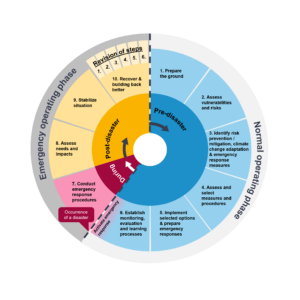Project facts
Presentation
Historic towns, old urban quarters, villages and hamlets, as well as historic landscapes make up a significant part of Europe’s identity: Natural heritage sites cover roughly 18% of the European land territory and on average 22% of the European housing stock was constructed before 1946. These historic areas are deeply embedded in larger urban and rural environments, serving a role in preserving local identity and personality as well as local knowledge.
Although climate change has become one of the most significant and fastest growing threats to people and their cultural heritage the impacts of climate-related and other natural hazards on historic areas have not been studied extensively and disaster risk reduction seldom registers as a priority area for management of World Heritage property.
Therefore, there is a need for specific methods and tools that provide better information and decision-support for climate change adaptation and disaster risk reduction for heritage managers, urban planners, policymakers and the general public. These methods and tools need to take the unique physical, environmental, economic, social, cultural, and political aspects of historic areas, as well as the enabling conditions these areas provide for taking action into account.
However, tools and methods alone are not enough. They need to be supported by a stronger promotion of relevant public policies and participatory governance processes, which include residents from local communities and a general public. The awareness of climate change impacts on historic areas needs to be increased, resilience building strategies need to be included in heritage management policies and practices, while at the same time the role heritage can play for climate change adaptation and disaster risk reduction within the wider urban context has to be emphasized.
The EU Horizon 2020 research project ARCH took a step in this direction. ARCH produced a suite of tools for assessing and improving the resilience of historic areas, targeted at heritage managers, urban planners, and other professionals from the fields of climate change adaptation, disaster risk management, and heritage management. In addition, ARCH – together with its sister projects SHELTER and HYPERION – founded the EU R&I Task Force on Climate-neutral and Resilience Historic Urban Districts, where policy makers, industry professionals, researchers, and practitioners from the heritage fields as well as local administrations come together to discuss needs, challenges, and opportunities for resilience of historic districts at the cross section of resilience, climate change adaptation, disaster risk management, and heritage management.
Impacts & Results
ARCH started with the production of a series of state-of-the-art reports of concepts, approaches, standards, and technologies on topics crucial for the project. These reports dealt with, amongst other things, the current state of conservation practices, the concepts of disaster risk management and building back better, gender mainstreaming, decision-support frameworks as well as existing standards related to the ARCH’s topics. Some of the key findings from these reports include:
- Cultural heritage management and disaster risk management remain poorly integrated.
- An indicator-based approach to risk assessments seems most appropriate for historic areas.
- Disaster risk management, for historic areas hinges critically on the inclusion of local communities, local practices, and traditional knowledge.
- Users need to be able to understand the decision process, limitations, and associated uncertainties of a Decision Support System (DSS).
In parallel to the state-of-the-art reports, four City Baseline Reports were compiled that establish the baseline for the municipalities of Bratislava, Camerino, Hamburg, and Valencia, with respect to their selected historic areas. As ARCH has a multi-dimensional thematic focus on 1) cultural heritage management, 2) disaster risk reduction and 3) adaptation to climate change, all three dimensions were addressed in each city’s baseline review.
Based on these reports, project partners conducted match-making meetings with each city to match local problems with specific solutions provided by ARCH. These meetings, as well as all co-creation activities of the project, are governed by an ARCH co-creation guideline document that presents a harmonised methodological approach and framework for the cooperation between scientific partners and a city.
In addition to the match-making meetings, each ARCH pilot city identified ‘local partnerships’ and developed a work plan for local activities, aligned with the research work of the project.
ARCH also looked beyond its pilot cities and compiled a report that maps and characterises European initiatives and case studies on advancing the resilience of cultural heritage to natural and human-induced disasters as well as to the long-term consequences of climate change. Forty initiatives are featured in this report, 32 as snapshots and 8 as case studies.
In order to ensure that the solutions developed by ARCH were in line with the needs of local end-users, as expressed in the match-making sessions, and with current practices, a requirements analysis was conducted and system specifications were drawn up. ARCH partners identified 134 requirements across the four pilot cities, each mapped to one or more of the solutions that will be developed by the ARCH project partners.
Based on the exploratory work, ARCH has developed a combined disaster risk management (DRM) and climate change adaptation cycle, the ARCH Disaster Risk Management Framework. The ARCH DRM Framework is specifically aimed at historic areas and helps actors in the fields of heritage management, disaster risk management and climate change adaptation to understand which steps are necessary to develop a combined disaster risk management and climate change adaptation plan with specific focus on historic areas. This framework has been adopted and advanced in a CEN Workshop Agreement in order to transfer project results into standardization processes.

The framework is supported with by a Resilience Knowledge Base, the ARCH HUB, which provides guidance, best practices, and helpful tools. This includes results procudes by ARCH, including
- a geoinformation management system (ARCH HArIS/THIS) that combines information on the conditions of historic areas and assets (including social, cultural, economic, environmental, and other elements) with hazard information (e.g. temperature, precipitation, air pollution)
- a number of dashboards for risk analysis, using the information from the geinformation management system (ARCH DSS)
- a database of more than 250 resilience measures (RMI) as well as a web-tool for planning and evaluation of implementation pathways (RPVT), and
- an online tool for the collaborative assessment and monitoring of the resilience maturity of a historic area (RAD)
These tools have been complemented by scientific work, e.g. on vulnerability and risk analyses, hazard models, and more, which can be access on the project website.
The project results have been tested and validated not just by ARCH’s four pilot cities (Foundation cities), but also by a larger circle of 12 European cities (Keystone Cities) as part of ARCH’s Mutual Learning Framework.
As part of the EU R&I Task Force, ARCH partners have also published a joint Whitepaper on needs, challenges, and opportunities for resilient historic districts.

